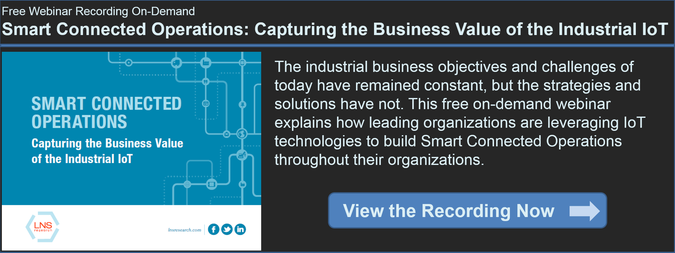 On May 19, along with other members of the LNS Research team, I hosted a webinar entitled "Smart Connected Operations: Capturing the Business Value of the Industrial IoT." We were excited at the level of interest and engagement in the event, bolstering our view that the Internet of Things is for real, and that the time to become educated about current and future possibilities is now.
On May 19, along with other members of the LNS Research team, I hosted a webinar entitled "Smart Connected Operations: Capturing the Business Value of the Industrial IoT." We were excited at the level of interest and engagement in the event, bolstering our view that the Internet of Things is for real, and that the time to become educated about current and future possibilities is now.
As is usual with these types of events, there is never enough time to get to every question asked by the attendees in the time alloted. So below, I want to address the top eight questions we received from attendees.
As a quick recap, for those who were unable to attend the live event, it was focused on the emerging paradigm of Smart Connected Operations, and the cyber-physical, automated/intelligent systems that are being developed through IoT capabilities and driving value for forward looking manufacturers. It also took a look at the current attitudes around IIoT in the marketplace, and gave recommendations for what's needed to further educate and advance the space. Specifically, it covered:
- The top objectives and challenges manufacturers face today, and how Smart Connected Operations are being employed to accelerate success
- Why 47% of manufacturers are still unclear on the value of the IIoT, and what needs to be done about it
- The four key areas of IIoT platform development: Cloud, Connectivity, Application Development, and Big Data Analytics
- Steps for building a business case for IIoT
- Examples of current successful pilot projects leveraging IoT capabilities
The Full on-demand recording of the webcast can be accessed here.
Questions & Answers
Q. Will the ISA-95 hierarchy still stay relevant in IIoT, or will we see direct connections from wireless sensors to the enterprise level?
A. Yes, and yes. The ISA-95 hierarchy will remain relevant but only through its ability to evolve over time and accomodate the direct connections that were previously unable to be made.
Q. What are the challenges and directions for the evolution of standards for sensors' communication protocols?
A. The challenges today are mostly around multiple standards with differing interests supporting those standards. There are also some gaps between the standards that have traditionally supported the automation space and the newer standards supporting machine-to-machine communications in the IT space.
Q. How can IIoT be used to save energy in industrial operations? Where are the opportunities?
A. One of the biggest challenges in Industrial Energy Management (IEM) is cheaply collecting granular energy consumption data and correlating this useage to production, maintenance, and environmnetal performance. IIoT technologies can address both of these challenges.
Q. What are the manufacturing verticals that are likely to see uptake of IIoT?
A. We are already seeing adoptions within several process industries, like oil & gas and chemicals, as well as utilities, where companies have outfitted distribution networks and delivery systems such as pipelines with smart sensors. We referenced a few examples in a recent LNS Weekly Roundup. Additionally, at almost every use group or vendor symposium we've visited in the past six months, there's been a compelling IoT use case story, involving improvements derived from IoT data allowing for improved asset reliability, lower maintenance costs, and energy savings. While the concentration of these use cases has been skewed toward process and energy-intensive industries, we're beginning to see evidence of this spreading to other manufacturing verticals like electronics manufacturing as well.
Q. Regarding IIoT adoption: How do the adopters relate to company size?
A. IIoT adoption today has been highly focsed on manufacturers looking to change business models from one of selling capital to selling capacity. In general these companies are mid to large manufacturers. Over time this will extend into Smart Connected Operations, which cover everything from the large process manufacturers to discrete manufacturers serving consumers as well as many of the small manufacuters from every industry.
Q. How should L1 manufacturers position themselves to best integrate into the coming IIoT platform?
A.There are multiple ways to integrate with the coming IIoT platform, participation in standards groups, support industry associations, and engagement in strategic partnerships. All have particular strengths and weaknesses.
Q. How much will the OT contribute to meeting ISO 50001 energy management information system reporting?
A. Much of the ISO 50001 standard is focused on the roles and responsibilities needed to drive continous improvement in energy useage. However, unlike other standards, ISO 50001 demands documented and ongoing performance improvement, and this means after the first few years companies are going to have to move beyond low-hanging fruit, which is where OT comes into the equatrion.
Q. How do you see the acceptance of IIoT manifesting in developing economies like India and China?
A. India and China are both moving full-steam ahead in the IIoT. India has its "Make in India" initiative and was the partner country at Hannover Messe this year. China has its 2025 vision and wants to ingrain as much Inudstrie 4.0 technology in its own manufacturing as possible.
